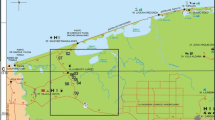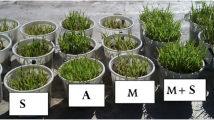Abstract
Goal, Scope and Background
This glasshouse study is aimed at evaluating tropical plants for phytoremediation of petroleum hydrocarbon-contaminated saline sandy subsurface soils. Tropical plants were selected for their ability to tolerate high salinity and remove No. 2 diesel fuel in coastal topsoil prior to further investigation of the phytoremediation feasibility in deep contaminated soils. The residual petroleum-hydrocarbon contaminant at the John Rogers Tank Farm site, a former petroleum storage facility, at Hickam Air Force Base, Honolulu, Hawaii, is located in a coastal area. It lies below a layer of silt in the subsurface, in loamy sand characterized by moderate salinity and high pH. Little is known regarding the ability of tropical plants to remediate petroleum hydrocarbon-contaminated subsurface soil in Hawaiian and other Pacific Island ecosystems although suitable plants have been identified and utilized for bioremediation in surface soil or marine sediments. Methods. The experiments were conducted in long narrow pots under glasshouse conditions in two phases. A preliminary experiment was done with nine tropical plants: kiawe(Prosopis pallida), milo(Thespesia populnea), common ironwood(Casuarina equisetifolia), kou(Cordia subcordata), tropical coral tree(Erythrina variegata), false sandalwood(Myoporum sandwicense), beach naupaka(Scaevola sericea), oleander(Nerium oleander), and buffelgrass(Cenchrus ciliaris). These plants were screened for resistance to high salinity treatment (2% NaCl) and two diesel fuel levels (5 and 10 g No. 2 diesel fuel/kg soil) in separate treatments. Plants that showed good tolerance of both factors were further evaluated in a second phase for their efficacy in the phytoremediation of diesel-fuel petroleum hydrocarbons under moderate salinity treatment (1% NaCl). Results. Tropical coral tree and buffelgrass were susceptible to either 2% NaCl or diesel fuel at 10 g/kg soil, but tolerant of diesel fuel at 5 g/kg soil. Kiawe, milo, kou, common ironwood,N. oleander, beach naupaka and false sandalwood were tolerant of high salinity (2% NaCl) or high diesel fuel level (10 g/kg soil). These seven plants were also tolerant of the combined adverse effects of a moderate salinity (1% NaCl) and 10 g diesel fuel/kg soil. Three trees, kiawe, milo and kou significantly accelerated the degradation of petroleum hydrocarbons in the soil spiked with 10 g diesel fuel/kg soil under a moderate salinity treatment (1% NaCl).
Conclusion
Thus the tropical woody plants, kiawe, milo and kou showed potential for use in phytoremediation of petroleum hydrocarbons in coastal tropical soils.
Recommendations and Outlook
Two fast growing trees, milo and kou, appeared promising for further phytoremediation evaluation in experiments that simulate the soil profile at the field site.
Similar content being viewed by others
Abbreviations
- JRTF:
-
the John Rogers Tank Farm
- Fm :
-
the maximum fluorescence value at predawn or in the dark
- Fo :
-
the minimum fluorescence value in the dark-adapted stage
- Fm :
-
the maximum fluorescence value in the light
- Fs :
-
the minimum fluorescence value in the light
- TPH-D:
-
total petroleum hydrocarbon-diesel range
References
Aprill W, Sims RC (1990): Evaluation of the use of prairie grasses for stimulating polycyclic aromatic hydrocarbon treatment in soil. Chemosphere 20, 253–265
Banks MK, Govindaraju RS, Schwab AP, Kulakow P (2000): Part I: Field Demonstration. In: Phytoremediation of Hydrocarbon-Contaminated Soil (Fiorenza S, Oubre CL, Ward CH, Eds) pp. 3–88 Lewis Publishers, Boca Raton, FL
Golla WM, Reid JJ (2001): Phytoremediation for hydraulic control of shallow groundwater impacted by petroleum hydrocarbons. Com Soils 6, 45–59
Gudin C, Syratt WJ (1975): Biological aspects of land rehabilitation following hydrocarbon contamination. Environ Poll 8, 107–112
Gunther T, Dornberger U, Fritsche W (1996): Effects of ryegrass on bio- degradation of hydrocarbons in soil. Chemosphere. 33, 203–215
Hue NV, Campbell S, Li QX, Lee CR, Fong J (2003): Reducing salinity and organic contaminants in the Pearl Harbor dredged material using soil amendments and plants. Fed Fac Environ J Rem 12, 37–56
Hutchinson SL, Banks MK, Schwab AP (2001): Phytoremediation of aged petroleum sludge: effect of inorganic fertilizer. J Environ Qual 30, 395–403
Jones RK, Sun WH, Tang CS, Robert FM (2004): Phytoremediation of petroleum hydrocarbons in tropical coastal soils: II. Microbial response to plant roots and contaminant. ESPR — Environ Sci & Pollut Res http://dx.doi.org/10.1065/espr2004.05.199.2
McCutcheon SC, Schnoor JL (eds) (2003): Phytoremediation: Transformation and Control of Contaminants. John Wiley and Sons, New York
Olson PE, Fletcher JS (1999): Field evaluation of mulberry root structure with regard to phytoremediation. Biorem J 3, 27–33
Palmroth MRT, Pichtel J, Puhakka JA (2002): Phytoremediation of subarctic soil contaminated with diesel fuel. Biores Technot 84, 221–228
Paquin D, Ogoshi R, Campbell S, Li QX (2002): Bench-Scale phytoremediation of polycyclic aromatic hydrocarbon-contaminated marine sediment with tropical plants. Int J Phytorem 4, 297–313
Pradhan SP, Conrad JR, Srivastava VJ (1998): Potential of phytoremediation for treatment of PAHs in soil at MGP sites. J Soil Cont 7, 467–480
Qiu X, Leland W, Shah SI, Sorensen DL, Kendall EW (1997): Field study: grass remediation for clay soil contaminated with polycyclic aromatic hydrocarbons. In: Kruger EL, Anderson TA, Coats JR (Eds). Phytoremediation of Soil and Water Contaminants. ACS Symposium Series 664, American Chemical Society, Washington, DC, pp 186–199
Reilley KA, Banks MK, Schwab AP (1996): Organic chemicals in the environment: dissipation of polycyclic aromatic hydrocarbons in the rhizosphere. J Environ Qual 25, 212–219
Riser-Roberts E (1998): Remediation of petroleum contaminated soils. Lewis Publishers, Boca Raton, FL
Trapp S, Köhler A, Larsen LC, Zambrano KC and Karlson U (2001): Phytotoxicity of fresh and weathered diesel and gasoline to willow and poplar trees. J Soils & Sediments 1, 71–76
United States Environmental Protection Agency (2000): Introduction to Phytoremediation. Office of Research and Development. EPA/600/R-99-107
Van Kooten O, Snel JFH (1990): The use of chlorophyll fluorescence nomenclature in plant stress physiology. Photosyn Res 25, 147–150
Author information
Authors and Affiliations
Corresponding author
Additional information
Part II (forthcoming): Microbial Response to Plant Roots and Contaminants
Rights and permissions
About this article
Cite this article
Sun, W.H., Lo, J.B., Robert, F.M. et al. Phytoremediation of petroleum hydrocarbons in tropical coastal soils I. selection of promising woody plants. Environ Sci & Pollut Res 11, 260–266 (2004). https://doi.org/10.1007/BF02979634
Received:
Accepted:
Issue Date:
DOI: https://doi.org/10.1007/BF02979634




